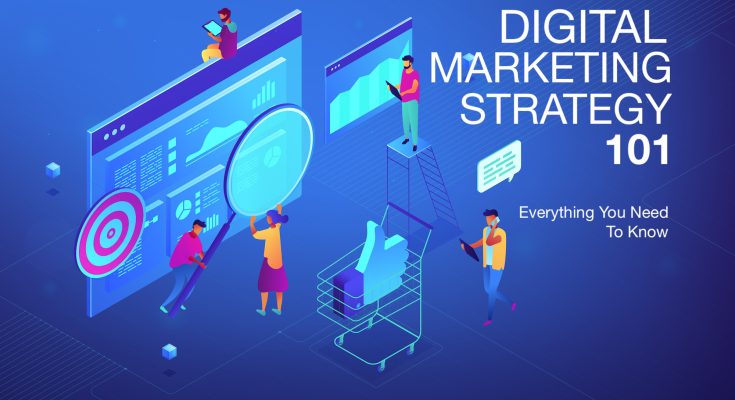In today’s digital-first world, establishing an online presence isn’t just an option—it’s a necessity. Whether you’re a small business owner, a freelancer, or a marketing professional, understanding the fundamentals of digital marketing is key to achieving success in the online landscape. While the field might seem overwhelming with its array of strategies and platforms, the truth is, effective digital marketing can be straightforward with the right approach. This guide simplifies digital marketing into actionable steps to help you create a roadmap to online success.
What is Digital Marketing?
Digital marketing encompasses all efforts to promote products, services, or brands through digital channels. These channels include websites, social media, search engines, email, and mobile apps. Unlike traditional marketing, digital marketing allows you to target specific audiences, track results in real time, and make data-driven decisions to optimize campaigns.
Key components of digital marketing include:
- Search Engine Optimization (SEO)
- Content Marketing
- Social Media Marketing
- Email Marketing
- Pay-Per-Click (PPC) Advertising
- Affiliate Marketing
- Analytics and Performance Tracking
Step 1: Define Your Goals
Every successful marketing strategy starts with clear goals. Before diving into specific tactics, ask yourself:
- What do I want to achieve with digital marketing?
- Who is my target audience?
- How will I measure success?
Your goals might include increasing website traffic, generating leads, boosting brand awareness, or driving sales. By establishing clear objectives, you can tailor your marketing efforts to achieve meaningful results.
Example: If your goal is to increase website traffic, focus on SEO, blogging, and social media promotion. If your priority is generating leads, invest in email marketing campaigns and landing pages.
Step 2: Understand Your Audience
Knowing your audience is the cornerstone of effective digital marketing. To create content and campaigns that resonate, you need to understand their needs, preferences, and behaviors.
- Create Buyer Personas: Develop detailed profiles of your ideal customers, including demographics, interests, challenges, and buying habits.
- Research Your Audience: Use tools like Google Analytics, social media insights, and surveys to gather data about your audience’s preferences and online activity.
- Segment Your Audience: Divide your audience into segments based on factors like age, location, or buying behavior. This enables you to deliver personalized messages that drive engagement.
Step 3: Build a Strong Online Presence
Your online presence serves as the foundation for all digital marketing efforts. Here’s how to establish a strong base:
1. Optimize Your Website
Your website is often the first point of contact with potential customers. Ensure it’s user-friendly, visually appealing, and optimized for search engines.
- Responsive Design: Make your site mobile-friendly to cater to users on all devices.
- Fast Loading Times: Slow websites drive users away. Use tools like Google PageSpeed Insights to improve loading times.
- Clear Navigation: Make it easy for visitors to find information with a clean, intuitive design.
- SEO Optimization: Use relevant keywords, meta descriptions, and alt tags to improve your site’s visibility in search results.
2. Leverage Social Media
Social media platforms are powerful tools for connecting with your audience and building brand awareness.
- Choose the Right Platforms: Focus on platforms where your target audience spends the most time.
- Post Consistently: Maintain a regular posting schedule to stay top-of-mind.
- Engage with Followers: Respond to comments, answer questions, and participate in conversations to build relationships.
Step 4: Develop a Content Strategy
Content marketing is at the heart of digital marketing. High-quality, valuable content attracts and engages your audience, positioning your brand as an authority in your industry.
Types of Content to Consider:
- Blog posts
- Videos
- Infographics
- Ebooks
- Webinars
Best Practices for Content Marketing:
- Focus on Value: Create content that solves your audience’s problems or answers their questions.
- Be Consistent: Publish content regularly to build trust and keep your audience engaged.
- Optimize for SEO: Use keywords, headings, and internal links to improve search engine rankings.
- Repurpose Content: Turn blog posts into social media snippets, infographics, or videos to maximize reach.
Step 5: Drive Traffic with SEO
Search Engine Optimization (SEO) is essential for attracting organic traffic to your website. By optimizing your site for search engines, you can improve your rankings and reach more potential customers.
SEO Tips for Beginners:
- Keyword Research: Identify keywords your audience is searching for using tools like Google Keyword Planner or SEMrush.
- On-Page SEO: Optimize titles, meta descriptions, and headers with targeted keywords.
- Build Backlinks: Earn links from reputable websites to boost your site’s authority.
- Local SEO: Optimize for local searches by creating a Google My Business profile and including location-specific keywords.
Step 6: Engage Through Email Marketing
Email marketing remains one of the most effective ways to nurture leads and drive conversions. With a well-crafted email campaign, you can stay connected with your audience and encourage them to take action.
Tips for Successful Email Campaigns:
- Build Your List: Use sign-up forms, lead magnets, and exclusive offers to grow your email list.
- Segment Your Audience: Send targeted emails to specific segments for better engagement.
- Create Compelling Subject Lines: Grab attention with concise, intriguing subject lines.
- Include a Call-to-Action (CTA): Make it clear what action you want the reader to take.
Step 7: Utilize Paid Advertising
While organic strategies are essential, paid advertising can help you reach your goals faster. Platforms like Google Ads and Facebook Ads allow you to target specific audiences with precision.
Benefits of Paid Advertising:
- Immediate visibility
- Advanced targeting options
- Measurable ROI
Popular Paid Advertising Options:
- Search Ads: Appear at the top of search results for specific keywords.
- Social Media Ads: Promote your content on platforms like Instagram, LinkedIn, or TikTok.
- Display Ads: Use banners or visual ads to capture attention on websites.
Step 8: Analyze and Optimize
Digital marketing is an ongoing process of learning and improvement. Use analytics tools to track your performance and identify areas for improvement.
Key Metrics to Monitor:
- Website traffic
- Conversion rates
- Email open rates
- Social media engagement
Tools for Tracking Performance:
- Google Analytics
- SEMrush
- HubSpot
- Social media insights
Regularly review your campaigns to see what’s working and what isn’t. Experiment with new strategies, refine your approach, and optimize your efforts for better results.
Final Thoughts
Digital marketing doesn’t have to be complicated. By following these steps and focusing on your audience’s needs, you can create a winning strategy that drives results. Remember, consistency and adaptability are key—the digital landscape is constantly evolving, so stay informed and be ready to adjust your approach as needed. With the right plan and tools, you’re well on your way to achieving online success.



